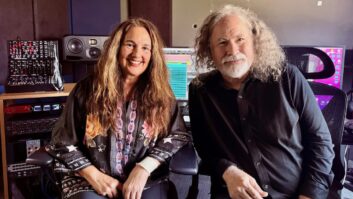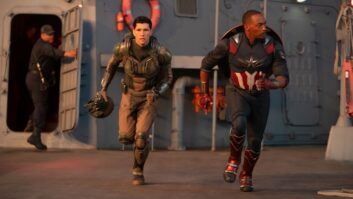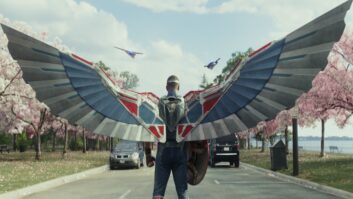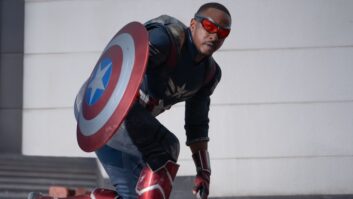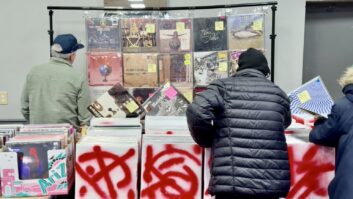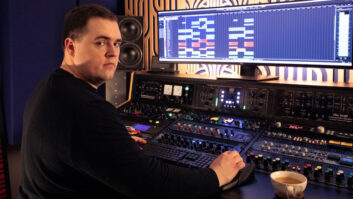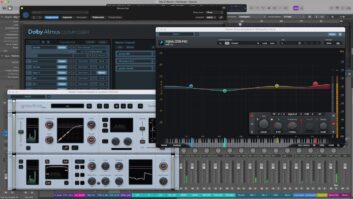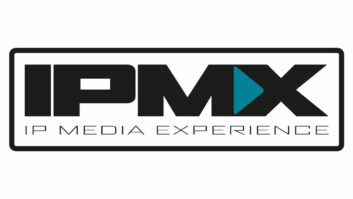Maybe it’s a feng shui thing, but “harmony” is the word that comes to mind when entering the Pacific Palisades home studio of Starr Parodi and Jeff Eden Fair. Although it’s part of L.A., the Palisades has always seemed to be some sort of an anachronism, serenely removed from the rest of L.A. Its weather is different, more Northern California-like with lots of fog and cool ocean breezes. Its vibe is different, too; the area often feels like a small town that just happens to be perched on hills overlooking the Pacific a few miles south of Malibu. Many successful artistic and musical types have carved out live/work spaces there, much as Parodi/Fair established Sonic Doppler-Gray Dog Studios.
Parodi and Fair write and produce together, and they have become known for their work in sound for picture, especially in the niche area of trailers. In the past year they’ve composed an update of the classic TV theme for Wild Wild West’s trailer, and mini-scores accompanying the trailers for Entrapment, The Mod Squad and The Thomas Crown Affair. Their trailer credits also include Braveheart, Deep Impact, Goldeneye and Tomorrow Never Dies. As busy as the trailer world keeps them, Parodi/Fair have also branched out to scoring for episodic television (Lifetime’s series Maggie) and feature films (The Eighteenth Angel, Screenland Drive), and they composed the musical background for the United Artists logo.
Back in 1985, Parodi was playing keyboards in saxophonist George Howard’s band while Fair was helping out with sound design for Howard’s album. “At the time, I was also doing some [music] writing for the TV show Fame,” recalls Parodi. “Jeff and I collaborated on some pieces that they used, and that’s how it started. We found that we worked really well together.” The couple is now married.
Although Parodi, who was born in Hollywood and educated at UCLA and at the Dick Grove School of Music, went on to play and tour with other artists, writing remained one of her main goals. The opportunity in 1988 to play with the Arsenio Hall Show posse helped get her on track.
“I was playing with a lot of different people,” she says, “and wondering how I could reconcile wanting to write with wanting to play. It always seemed that in order to write, you had to stay in town, but the people I was playing with were always going out on the road. Then Arsenio’s show came along and that was the perfect marriage. I got to stay in town and play with a really great band and a lot of my favorite artists, and also have the chance to write and get connected.”
At that time, Fair, who hails from Seattle and plays bass guitar, brass, woodwinds and guitar, was busy with record production, commercials and working as head of R&D at Hybrid Arts, one of the first companies designing professional music software. In an only-in-L.A. scenario, the two were introduced to the world of movie trailers by a neighbor. “He was a copywriter working on voice-overs for the trailer for Straight Out of Brooklyn,” explains Fair. “We’d given him a demo tape of music we’d done together, and he took it in to where he worked. The next day we got a call to come and meet.”
The trailer production process is, not surprisingly, a compressed version of movie scheduling. Logistics and time frames vary for each project, with, according to Fair, the average time around a week-and-a-half. Parodi/Fair, of course, prefer to come aboard as early as possible because, as Fair says, “That’s when a project can really gain its own identity.”
“Thematically, trailers may jump through four or five different styles in a two-minute, 17-second space of time,” Parodi adds. “It’s a big challenge to make the soundtrack cohesive. You’re trying to tell a two-hour story in less than three minutes, so you’re trying to convey all the different emotions and also make people want to go out and see the picture. You have to make it seem like it’s all one piece of music, or at least that it logically moves from piece to piece.”
Temp love is the film scoring equivalent of demo love in the record business. Directors often get tied to a piece of music based on the temp score, making the actual composer’s work more difficult. “It’s not uncommon for some music to be attached to the project when we get it,” says Fair, “but usually we try to take it in a more original direction. That’s another reason it’s great to get to come in early; then you know that the editor will be cutting the picture to your music, as opposed to cutting the picture to some other music that might inspire them. If they cut the picture to other music, you may be locked into a tempo-you’ll have to take that into consideration. You may have to resort to some tricks then, like making that tempo work in another time signature.”
Generally, the couple doesn’t see a film in its entirety before beginning work. “Sometimes we see artists’ renderings,” says Parodi, “or we might get a script. For Wild Wild West, we first saw conceptual art six months before we did the project. We did some demos on synth and sent them off, and that was that for a long time. Then we got a call about three days before they needed to take it to picture! Some deadlines had popped up and it was a rush for everybody. So it was lots of coffee and no sleep!”
Pre-recording of drums, bass, synth and percussion were done at Sonic Doppler, with sounds laid to DA-88 and 24-track. Then it was off to the Todd-AO soundstage, where Parodi conducted a 70-piece orchestra.
The eternal conflict between sound effects and music is just as prevalent in trailers as in feature films. “I think the best trailers,” says Fair, “are the ones that allow whatever is creating the emotion that’s necessary at any given moment to play through, whether it be sound effects or music.”
“Since everybody has heard explosions,” adds Parodi, “sometimes sound designers or the producer will go for having the music drive the scene. But it’s always a give-and-take situation, and it’s really important to be aware of all the sound design that’s going on. Quite often we work with the picture editor, so we know their ideas and what their hopes are for the marriage of music and sound effects. That helps us to know where we can step out musically and where we have to pull back.”
Parodi/Fair’s final mixes are delivered on DA-88 in sync with picture, generally comprising a stereo mix and separate stems for whatever may need to be in surround speakers or the subwoofer. “Usually, it will be on eight tracks, occasionally two DA-88s running in sync,” says Fair. “It’s not really delivered in LCRS, but we definitely give them the elements to place them in surround as they desire.”
A main feature of Sonic Doppler’s recording space is its circa 1928 7-foot Steinway piano, Parodi’s main composing instrument, although she maintains a large arsenal of other keyboards, including a Prophet-5, Korg T1 and Korg Trinity. “People always ask me why I don’t get rid of all these keyboards and just have one,” she laughs. “It’s because they all have different sound textures. They all help to bring to life different ideas.”
Depending on a project’s time frame and budget, recording is to a 24-track Otari MX80, DA-88 or Pro Tools. “If we’re doing stacks of instruments, we go digital to avoid tape noise,” says Fair. “But most of the time we still prefer the sound of the analog, even though its faster and more convenient in the hard drive world.”
Both Parodi and Fair are musical/technical hybrids-they obviously love sound for its own sake and put a lot of thought into capturing and creating it. The bright, spacious and wood-floored living room that houses the Steinway gets used for lots of other live instrument recording, with FC tube trap baffling applied as needed. Lots of experimentation with mic placement has taken place, and the couple have an extensive mic collection. Sankens and C41s are generally used on the piano, with the Swiss-made Sonosax mic preamp. “We compared the Sonosax to Neve, Demeter, API and V72s,” says Fair. “It won the shoot-out.”
Neumann KM54s sometimes get used on the piano, as does an interesting unnamed Chinese U67 knockoff. “Allen Sides actually told me about it,” offers Fair. “It has a 6072 tube in it, and they used to do modifications of it at Ocean Way. We often use it on cello and woodwinds,
Monitors are Tannoys, Auratones and Clements (“amazing and inexpensive”) with JBL 4311s for “Fun!” according to Parodi, “for when we want to turn it up loud for a guitar player without being afraid that we’ll blow our speakers!”
The CAD Maxcon console that was in house at the time of our interview was being replaced with a Soundcraft TS24, which both find to be “punchy and warm.” Favorite compressors at Sonic Doppler are an SSL stereo, LA2As and that new (visually unimpressive) secret weapon, the RNC (Really Nice Compressor), as well as the Waves Ultra L1 plug-in.
Cuebase is the team’s main composing tool, used with the MOTU 2408 audio interface. “We actually use that more than Pro Tools,” says Fair. “It’s getting to the point that you can do most of the Pro Tools functions inside Cubase, as well as the sequencing.”
Currently, Parodi and Fair are working on music for the Destination Films logo and the trailer for Bats. And although Parodi sees a possible solo musical album in her future, the two are hooked on composing music for picture. “There’s just something about the marriage of the two,” says Parodi. “The sum of the parts is bigger than music or picture alone, and that’s exciting to us.”
